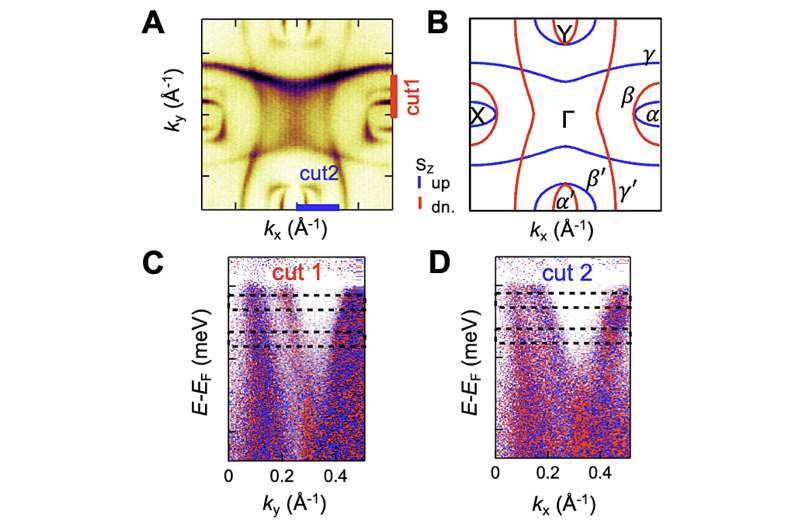The ARPES measured (A) and calculated (B) Fermi surface of Rb1-δV2Te2O. The blue and red colors in (B) indicate the opposite spin polarization, which is also proved by the Spin-resolved ARPES spectra shown in (C) and (D). Credit: Zhang et al
The Magnetic Puzzle Gets a New Piece
For over a century, physicists have categorized magnetic materials into two main families: ferromagnets, where magnetic moments align, and antiferromagnets, where they cancel each other out. Now, a new class has entered the scene—altermagnets—and they’re rewriting what we know about magnetism.
A team led by Dr. Chaoyu Chen from the Songshan Lake Materials Laboratory in China has created a layered metallic altermagnet that operates at room temperature, a first in the world of magnetic materials. This innovation opens up exciting new pathways for spintronics, a futuristic field where data is stored and processed using the spin of electrons, rather than their charge.
What Are Altermagnets—and Why Do They Matter?
Altermagnets are unique: like antiferromagnets, they exhibit no net magnetization (their magnetic moments cancel out), but they still break spin symmetry, like ferromagnets. That means they can polarize electron spins, which is essential for building efficient, ultra-fast, and low-energy spintronic devices.
Until now, all known altermagnets—like MnTe and CrSb—were three-dimensional and lacked the structural finesse to produce non-collinear spin currents, a critical component for advanced quantum devices.
The Breakthrough: Rb₁₋δV₂Te₂O
Dr. Chen’s team synthesized a compound called Rb₁₋δV₂Te₂O, a layered altermagnet capable of generating these elusive spin currents at room temperature. Their discovery, published in Nature Physics, involved a series of meticulous experiments including angle-resolved photoemission spectroscopy (ARPES) and scanning tunneling microscopy, which confirmed the material’s spin-split band structure and magnetic order.
Lead author Fayuan Zhang highlighted that this material was predicted theoretically in 2021, but this is the first real-world demonstration of its properties.
What This Means for the Future
With its 2D, layered structure, Rb₁₋δV₂Te₂O is ideal for stacking, twisting, or stretching—much like graphene—making it a strong candidate for next-gen quantum materials, superconductors, and Chern insulators.
“We now plan to fabricate spin transport devices using this material,” said Dr. Chen. “It’s the first step toward real-world spintronic applications.”
Why You Should Care
This new class of magnet could revolutionize how we build faster, smaller, and more energy-efficient electronics. From data centers to quantum computing, the potential is staggering.
Could altermagnets power the next tech revolution?
To stay on top of the latest advancements in science and technology, visit DailySciTech.com for fresh insights and discoveries every day!










